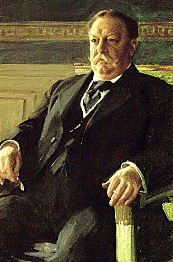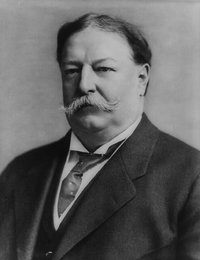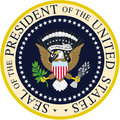William Howard Taft
|
|
| ||
| Order: | 27th President | |
| Vice President: | James S. Sherman | |
| Term of office: | March 4, 1909 – March 4, 1913 | |
| Preceded by: | Theodore Roosevelt | |
| Succeeded by: | Woodrow Wilson | |
| Date of birth: | September 15, 1857 | |
| Place of birth: | Cincinnati, Ohio | |
| Date of death: | March 8, 1930 | |
| Place of death: | Washington D.C. | |
| First Lady: | Helen Herron Taft | |
| Political party: | Republican party | |
William Howard Taft (September 15, 1857–March 8, 1930) was an American politician, jurist, and the 27th President of the United States, serving a single term from 1909 to 1913. A Republican, Taft served as Secretary of War, federal judge for the Sixth U.S. Circuit Court of Appeals, and Governor-General of the Philippines before being nominated for president in the 1908 Republican National Convention with the backing of his predecessor and close friend Theodore Roosevelt.
Taft defeated Democrat William Jennings Bryan in the presidential election, and during his presidency prosecuted the trusts, strengthened the Interstate Commerce Commission, expanded the civil service, and established a better postal system. Two constitutional amendments were passed during his term: the 16th Amendment, authorizing a federal income tax, and the 17th Amendment, mandating the direct election of senators by the people instead of by the state legislatures. Taft was the first president to occupy the Oval Office when it was opened in October 1909.
Taft later broke off contact with Roosevelt in one of the most well-publicized political feuds of the 20th century. In the 1912 election, Taft lost his bid for a second term; Roosevelt ran on his newly formed Progressive Party ("Bull Moose") ticket, splitting the Republican vote and resulting in the election of Woodrow Wilson. Taft later became Chief Justice, becoming the only president to serve on the U.S. Supreme Court.
| Contents |
Early life and career
Taft was born on September 15, 1857, in Cincinnati, Ohio. His mother was Louisa Torrey; his father was Alphonso Taft, a prominent Republican, who served as Secretary of War under President Ulysses S. Grant. Like his father, the younger Taft went to college at Yale University, where he was a member of Skull and Bones, the secret society co-founded by his father. He was also a member of the Beta chapter of the Psi Upsilon fraternal organization. After college, he attended Cincinnati Law School and began his political career in Ohio shortly after joining the bar in 1880.
In 1892, Taft was appointed by President Benjamin Harrison as an associate judge by for the newly created Sixth U.S. Circuit Court of Appeals, a post which he held until 1900. In 1900, President William McKinley appointed Taft as the chairman of a commission to organize a civilian government in the Philippines, which had been ceded to the United States by Spain following the Spanish-American War and the 1898 Treaty of Paris. From 1901 to 1903, Taft served as the first civilian Governor-General of the Philippines. In 1903, Theodore Roosevelt named Taft as Secretary of War, and he returned to the United States.
Taft was also overweight, to the point that he became stuck in the bathtub in the White House several times, prompting the installation of a new bathtub capable of holding all of the men who installed it. At 6 feet, and weighing over 350 pounds, Taft was the largest and heaviest President. There is some evidence that his mother started calling him "my pudgy-wudgy boy" before his fifth birthday. This may have led to his disdain for the word "pudgy." In fact, it was said that an aide blacked out "pudgy" from his morning newspaper.
Presidency

After serving nearly two full terms, popular Theodore Roosevelt refused to run in the election of 1908. Instead, he promoted Taft as the next Republican president. With Roosevelt's help, Taft handily defeated Democrat William Jennings Bryan. Throughout his presidency, Taft contended with dissent from more liberal members of the Republican party, many of whom continued to follow the lead of former President Roosevelt.
Taft fought for prosecution of trusts, further strengthened the Interstate Commerce Commission, established a postal savings bank and a parcel post system, expanded the civil service and sponsored the enactment of two amendments to the Constitution. The 16th Amendment authorized a federal income tax; the 17th Amendment, ratified in 1913, mandated the direct election of senators by the people, replacing the system whereby they were selected by state legislatures. He also signed legislation that created the United States Department of Labor.
Yet balanced against these achievements was Taft's acceptance of a tariff with protective schedules that outraged liberal opinion; his opposition to the entry of the state of Arizona into the Union because of its liberal constitution; and his growing reliance on the conservative wing of his party. By 1910 Taft's party was divided.
Progressive Republicans openly challenged Taft in the Congressional elections of 1910 and in the Republican presidential primaries of 1912. When Taft won the Republican nomination, the Progressives organized a rival party (the United States Progressive Party, a.k.a. "Bull Moose") and selected Theodore Roosevelt to run against Taft in the general election. Roosevelt's Bull Moose candidacy split the Republican vote and helped elect Democrat Woodrow Wilson.
Evidence from eyewitnesses and from Taft himself strongly suggests he had severe obstructive sleep apnea during his Presidential term of office, a consequence of his 300+ pound weight. His legendary tendency to fall asleep in almost any circumstance, an open secret and source of embarassment for his intimates, is now understood to have been the most obvious manifestation of the disease. The effect of sleep apnea on his Presidency has not been systematically evaluated; however, the annual conference of the Narcolepsy in Popular Culture Association will examine Taft's likely disorder during its June 2005 meeting in Salt Lake City. Within a year of leaving the Presidency Taft had lost approximately 60 pounds and his hypersomnolence resolved, though he ironically suffered from insomnia for the rest of his life.
Cabinet
| OFFICE | NAME | TERM |
| President | William Howard Taft | 1909–1913 |
| Vice President | James S. Sherman | 1909–1913 |
| Secretary of State | Philander C. Knox | 1909–1913 |
| Secretary of the Treasury | Franklin MacVeagh | 1909–1913 |
| Secretary of War | Jacob M. Dickinson | 1909–1911 |
| Henry L. Stimson | 1911–1913 | |
| Attorney General | George W. Wickersham | 1909–1913 |
| Postmaster General | Frank H. Hitchcock | 1909–1913 |
| Secretary of the Navy | George von L. Meyer | 1909–1913 |
| Secretary of the Interior | Richard A. Ballinger | 1909–1911 |
| Walter L. Fisher | 1911–1913 | |
| Secretary of Agriculture | James Wilson | 1897–1901 |
| Secretary of Commerce and Labor | Charles Nagel | 1909–1913 |
Supreme Court Appointments
Taft appointed the following Justices to the Supreme Court of the United States:
- Horace Harmon Lurton - 1910
- Charles Evans Hughes - 1910
- Edward Douglass White - Chief Justice - 1910 (an associate justice since 1894. His death made Taft chief justice)
- Willis Van Devanter - 1911
- Joseph Rucker Lamar - 1911
- Mahlon Pitney - 1912
States Admitted to the Union
Chief Justice
1925_U.S._Supreme_Court_Justices.jpg
From 1921 until 1930, Taft served on the Supreme Court as Chief Justice of the United States. He was the only President to do so, and the only former president to swear in future presidents. He gave the oath of office to both Calvin Coolidge and Herbert Hoover. In an effort to make the Court work more efficiently, he advocated passage of the 1925 Judges Act enabling the Supreme Court to give precedence to cases of national importance.
Taft retired as chief justice on February 3, 1930, due to ill health. He died five weeks later on March 8. Three days later, on March 11, he became the first American president to be buried at Arlington National Cemetery. His wife, Helen, believed his service as Secretary of War qualified him for burial there. It did because he oversaw the armed forces. In fact, anyone who served as president is entitled to burial at Arlington, as Commander-in-Chief of the armed forces.
A third generation of the Taft family entered the national political stage in 1938. The former president's oldest son, Robert A. Taft I, was elected to the United States Senate. A vociferous critic of the New Deal, Robert Taft was a Republican leader in the Senate from 1939-1953. His other son, Charles Phelps Taft II served as Mayor of Cinncinati, Ohio from 1955 to 1957. Two more generations of the Taft family later entered politics. The President's grandson, Robert Taft Jr., served a term as a Senator from Ohio from 1971-1977; the President's great-grandson, Robert A. Taft II, is the current Governor of Ohio. William Howard Taft III was U.S. ambassador to Ireland. William Howard Taft IV is a high official in the United States Department of State.
History Clipart and Pictures
- Pictures of the US Presidents (http://classroomclipart.com/cgi-bin/kids/imageFolio.cgi?direct=History/United_States/Presidents)
- Clipart of American Presidents (http://classroomclipart.com/cgi-bin/kids/imageFolio.cgi?direct=Clipart/American_Presidents)
- Historical Pictures of the United States (http://classroomclipart.com/cgi-bin/kids/imageFolio.cgi?direct=History/United_States)
- Pictures of the American Revolution (http://classroomclipart.com/cgi-bin/kids/imageFolio.cgi?direct=History/United_States/American_Revolution)
- Civil Rights Pictures (http://classroomclipart.com/cgi-bin/kids/imageFolio.cgi?direct=History/United_States/Civil_Rights)
- Civil War Images (http://classroomclipart.com/cgi-bin/kids/imageFolio.cgi?direct=History/United_States/Civil_War)
- Pictures of Colonial America (http://classroomclipart.com/cgi-bin/kids/imageFolio.cgi?direct=History/United_States/Colonial_America)
- Historical US Illustrations (http://classroomclipart.com/cgi-bin/kids/imageFolio.cgi?direct=History/United_States/Illustrations)
- World War II Pictures (http://classroomclipart.com/cgi-bin/kids/imageFolio.cgi?direct=History/United_States/World_War_II)
- Pictures of Historical People (http://classroomclipart.com/cgi-bin/kids/imageFolio.cgi?direct=History/United_States/People)
Related articles
- Taft family
- U.S. presidential election, 1908
- U.S. presidential election, 1912
- History of the United States (1865-1918)
- Dollar Diplomacy
External links
- Inaugural Address (http://www.yale.edu/lawweb/avalon/presiden/inaug/taft.htm)
- Audio clips of Taft's speeches (http://vvl.lib.msu.edu/showfindingaid.cfm?findaidid=TaftW)
- Taft's sleep apnea (http://www.apneos.com/taft_intro.html)
- Taft's medical history (http://www.doctorzebra.com/prez/g27.htm)


